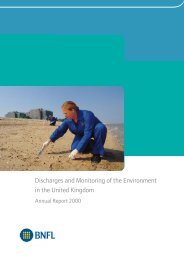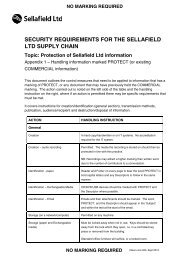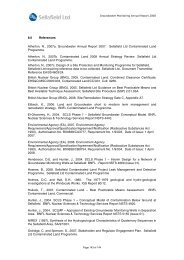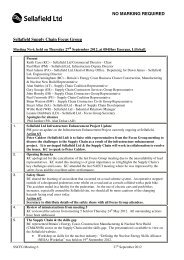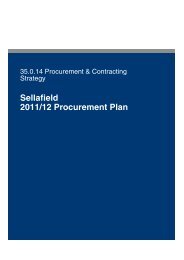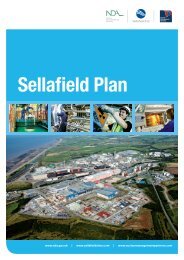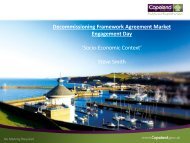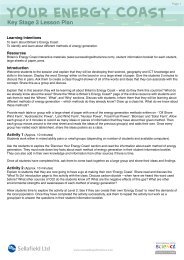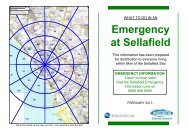Annual Report for 2010/11 and Forward Programme - Sellafield Ltd
Annual Report for 2010/11 and Forward Programme - Sellafield Ltd
Annual Report for 2010/11 and Forward Programme - Sellafield Ltd
You also want an ePaper? Increase the reach of your titles
YUMPU automatically turns print PDFs into web optimized ePapers that Google loves.
SSEM/20<strong>11</strong>/4730 June 20<strong>11</strong>The numbers of alpha-rich finds have increased since the introduction of the Synergysystem. This may be attributable to the improvements in detection sensitivity but thishas not been proven. If there are more alpha-rich finds present on the beaches thanpreviously thought, the risk assessment will need to be reviewed.Capabilities of the beach monitoring systems <strong>for</strong> detection of alpha-rich objects atdepth are limited by the physical nature of the detection process <strong>and</strong> the availabletechnology. These capabilities may not meet the requirements needed to ensuredetection of particles that could give rise to a significant risk to health if ingested. Iftechnical advances are made that would allow more reliable detection of alpha-richparticles at greater depths, these should be considered <strong>for</strong> implementation.For some beaches, particularly where the number of objects found is low, theuncertainties in the estimate of the actual number of objects present can be quitelarge. The accuracy of the risk assessment would be improved when more monitoringdata is available <strong>and</strong> if more accurate data were available on the depths of particlesdetected.These recommendations will be discussed by <strong>Sellafield</strong> <strong>Ltd</strong>, the EA <strong>and</strong> the HPA at ameeting in July 20<strong>11</strong>. Also, since this report was produced, HPA have been asked by the EAto update their assessment based on data collected since the introduction of the Synergymonitoring system in August 2009. A draft proposal has been produced <strong>for</strong> this work <strong>and</strong> thefindings are expected to be reported in 20<strong>11</strong>/12 financial year.5.3 Risks to workersThe HPA assessment focuses on health risks from radioactive objects to the public,accounting <strong>for</strong> both low probabilities of contact with objects <strong>and</strong> low levels of harm if contactwere to occur. Their report does not specifically address issues associated with workers whoobtain data <strong>and</strong> seek <strong>and</strong> recover radioactive objects from beaches. We have sought advicefrom a qualified Radiological Protection Advisor employed by <strong>Sellafield</strong> <strong>Ltd</strong> to providereassurance that adequate measures have been taken by Nuvia to protect its workers.5.3.1 Nuvia operationsUse of Groundhog Evolution2 <strong>and</strong> Synergy, <strong>and</strong> associated recovery methods, requiresspecific assessment of risk to Groundhog operators. Operations involve response to a ‘find’alarm in the Groundhog cabin <strong>and</strong> then use of h<strong>and</strong>held radiation instruments <strong>and</strong> tools toretrieve objects from the beach. Objects are transferred to sealed containers <strong>for</strong> transport to<strong>Sellafield</strong> site <strong>for</strong> analysis.A number of the hazards identified in the HPA reports (Brown <strong>and</strong> Etherington, 20<strong>11</strong>; Oatway., 20<strong>11</strong>) apply <strong>for</strong> these operations, including potential <strong>for</strong> inhalation, ingestion, skincontact <strong>and</strong> wounds. These are commented on below, together with some of the associatedcontrols.Activity levels of particles are low enough not to cause significant external radiation tooperators <strong>and</strong> so this is not considered further as a significant protection issue. The HPAreport came to the same conclusion <strong>for</strong> the public. Of course, as part of compliance withtransport regulations, radiation measurements of containers are per<strong>for</strong>med prior to transfer ofthe finds to <strong>Sellafield</strong> site.Inhalation, ingestion, <strong>and</strong> wounds are routes where radioactivity can deliver internal dose.The deliberate proximity of the operators to found objects negates the low probabilities© Nuclear Decommissioning Authority 20<strong>11</strong>. 80



